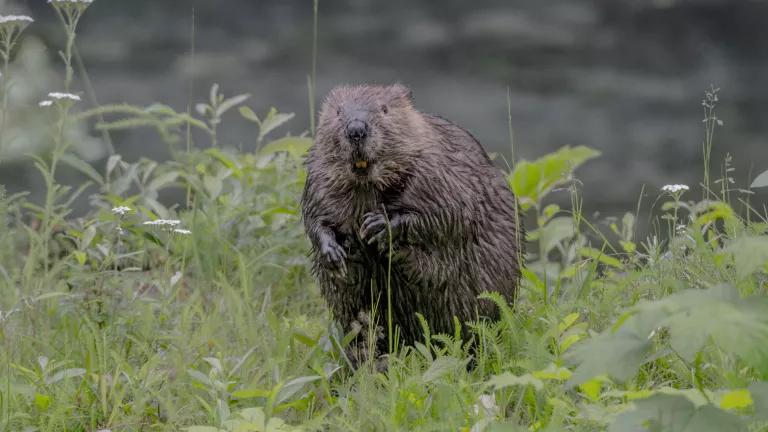
Guest blog by Anna Wearn, Water Program Assistant & Susan McGuigan, Pro Bono Attorney
The Susitna River depicted above,
- Flows freely for over 300 miles, from the rugged peaks of the Alaska Range out to the Cook Inlet and ultimately to the Pacific Ocean;
- Is the 15th largest drainage in the United States, providing a home for dozens of species of iconic mammals, including moose, caribou, bear, and wolf, and an abundance of migratory bird species, including Bald and Golden Eagles;
- Hosts Alaska’s second largest recreational Chinook salmon fishery and its basin hosts one of the world’s the top ten remaining Sockeye salmon populations.

This wild Alaskan river and its watershed are currently threatened by a proposal to build the nation’s second tallest dam (735 feet tall) near Denali National Park. The massive Susitna-Watana hydroelectric project (including a reservoir 42 miles long and a mile wide) would completely alter the river’s natural processes, thereby seriously degrading one of our country’s last remaining free-flowing rivers and its vulnerable, subarctic ecosystem. Rivers like the Susitna that flow to the ocean unencumbered by major development are a safe haven for some of the world’s largest salmon populations. This makes the Susitna a very poor choice as a site for the kind of large-scale dams that have wreaked havoc on fish populations throughout the lower 48 and are being removed across the country. There are far better alternatives to meet our clean power needs than one that undermines a uniquely undisturbed river currently supporting critical fish and wildlife populations, and the local livelihoods depending on them.
Governor Walker “closes down” the project, and yet it limps on
In light of fiscal challenges in Alaska (driven by falling oil prices), Governor Walker announced in June that he would no longer authorize funding for the Alaska Energy Authority (AEA) to continue work on the Susitna-Watana project, which the applicant estimates to cost $5.66 billion (a figure that still omits billions in associated costs). The Governor’s decision is the right choice for Alaska’s environment and economy but only marks a first step. Local communities are still waiting for the nail in the coffin for this “zombie” dam project, which has resurfaced several times over the past half-century during periods when the state grew flush with oil revenues.
In March, the Federal Energy Regulatory Commission (FERC) will rule whether AEA must fix and/or redo its poorly conducted environmental analysis, as urged by the federal agencies responsible for reviewing the studies. Addressing these agency concerns with the data and methodology in order to accurately assess the environmental impacts of the mega dam will be costly and time consuming. Furthermore, dragging on the process is inconsistent with the Governor’s stated intent to “close down” the project. Instead of wasting more time and scarce state funds, AEA should withdraw its pending application for a preliminary permit as soon as FERC makes its determination this spring.
The dam’s impacts would be devastating to the region’s economy and ecosystem

The Susitna River basin’s pristine and intact ecosystem is the foundation of the regional economy and makes the area Alaska’s most popular destination for hunters and anglers. The local sport fishing industry generates up to 1,900 jobs and $64 million of personal income for residents, as well as up to $15 million in state and local taxes. Commercially, the Susitna is one of the largest salmon-producing rivers in the upper Cook Inlet fisheries, which harvest four million salmon and generate $34.2 million annually. But federal fish biologists are concerned about the threats the dam presents to local salmon runs by blocking access to spawning grounds, upending the river’s natural patterns (including flow, temperature, and sedimentation) and degrading downstream water quality and habitat. Wildlife would also suffer, with the 23,500 acre reservoir inundating critical winter habitat for riparian animals like moose while fragmenting habitat of migratory animals like caribou.
Climate scientists have determined that Alaska is warming at twice the rate of the rest of the nation, which has caused a cascade of hydrologic effects throughout the state, including melting glaciers and permafrost and associated changes to surface water temperature and flow. As the Susitna’s waters warm and the basin’s glaciers recede, the dam’s operations will only exacerbate the stress that such disruption creates for salmon populations.
High time to actually “shut it down”
It is evident that the dam poses threats not only to fish and wildlife, but also to the fishing and tourism industry at the heart of the local economy. However, after $192 million in state funds spent on years of poorly conducted studies, AEA has failed to clearly or accurately assess exactly what those impacts are likely to be. Federal agencies, along with environmental groups and citizens, have submitted comments to FERC criticizing the poor data collection and modelling techniques used by AEA to predict impacts to the Susitna ecosystem, and have asked FERC to order new studies and modifications to the studies already undertaken. Ultimately, many more years of study and millions of dollars would be required to truly understand the magnitude of impacts of construction and operation of the dam on this vulnerable watershed. In order to complete the task of closing down the Susitna-Watana project, the state needs to withdraw the application as soon as FERC makes its ruling in March, if not before.



